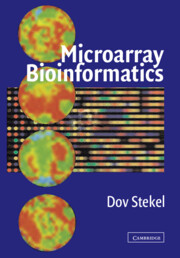Book contents
- Frontmatter
- Contents
- Foreword
- Preface
- Acknowledgments
- MICROARRAY BIOINFORMATICS
- 1 Microarrays: Making Them and Using Them
- 2 Sequence Databases for Microarrays
- 3 Computer Design of Oligonucleotide Probes
- 4 Image Processing
- 5 Normalisation
- 6 Measuring and Quantifying Microarray Variability
- 7 Analysis of Differentially Expressed Genes
- 8 Analysis of Relationships Between Genes, Tissues or Treatments
- 9 Classification of Tissues and Samples
- 10 Experimental Design
- 11 Data Standards, Storage and Sharing
- Appendix: MIAME Glossary
- Index
- Plate section
9 - Classification of Tissues and Samples
Published online by Cambridge University Press: 15 January 2010
- Frontmatter
- Contents
- Foreword
- Preface
- Acknowledgments
- MICROARRAY BIOINFORMATICS
- 1 Microarrays: Making Them and Using Them
- 2 Sequence Databases for Microarrays
- 3 Computer Design of Oligonucleotide Probes
- 4 Image Processing
- 5 Normalisation
- 6 Measuring and Quantifying Microarray Variability
- 7 Analysis of Differentially Expressed Genes
- 8 Analysis of Relationships Between Genes, Tissues or Treatments
- 9 Classification of Tissues and Samples
- 10 Experimental Design
- 11 Data Standards, Storage and Sharing
- Appendix: MIAME Glossary
- Index
- Plate section
Summary
INTRODUCTION
One of the most exciting areas of microarray research is the use of microarrays to find groups of genes that can be used diagnostically to determine the disease that an individual is suffering from, or prognostically to predict the success of a course of therapy or results of an experiment.
In these studies, samples are taken from several groups of individuals with known pathologies, outcomes or phenotypes and hybridised to microarrays. The aim is to find a small number of genes that can predict to which group each individual belongs. These genes can then be used in the future as part of a molecular test on further individuals, either using a focussed microarray, or a simpler method such as quantitative polymerase chain reaction (PCR).
EXAMPLE 9.1 DATA SET 9A
Bone marrow samples are taken from 27 patients suffering from acute lymphoblastic leukemia (ALL) and 11 patients suffering from acute myeloid leukaemia (AML) and hybridised to Affymetrix arrays. We want to be able to diagnose the leukemia in future patients using either Affymetrix technology or usingmore focussed arrays with a small number of genes. How do we choose a set of rules to classify these samples?
The development of such predictive models depends on statistical and computational techniques, many of which are still the subject of active research. There are essentially three parts to developing a predictive model, and so the chapter is arranged into three further sections:
Section 9.2: Methods of Classification, looks at a number of commonly used methods for distinguishing between groups of individuals based on a given set of measurements. There are several well-established methods for doing this, many of which have been shown to work well with microarray data.
[…]
- Type
- Chapter
- Information
- Microarray Bioinformatics , pp. 183 - 210Publisher: Cambridge University PressPrint publication year: 2003



